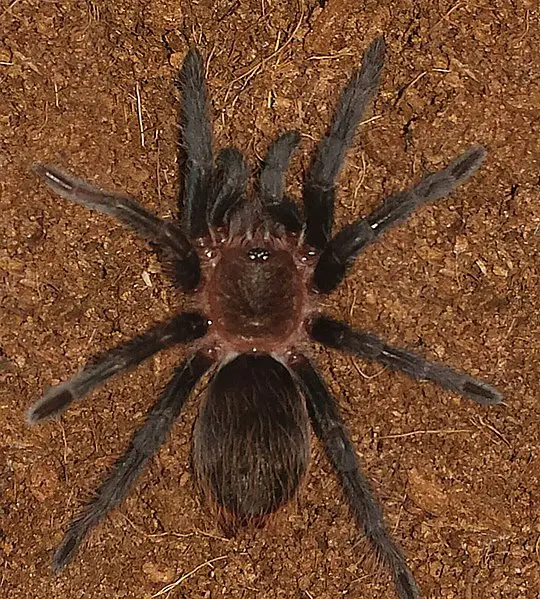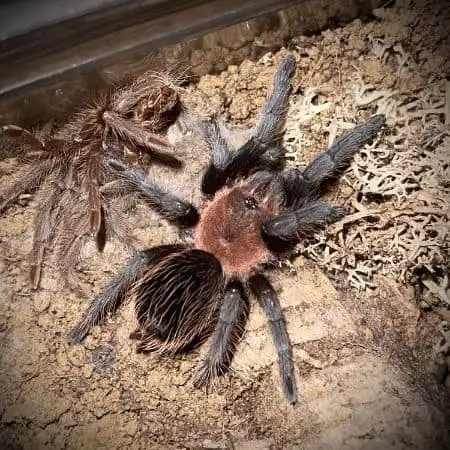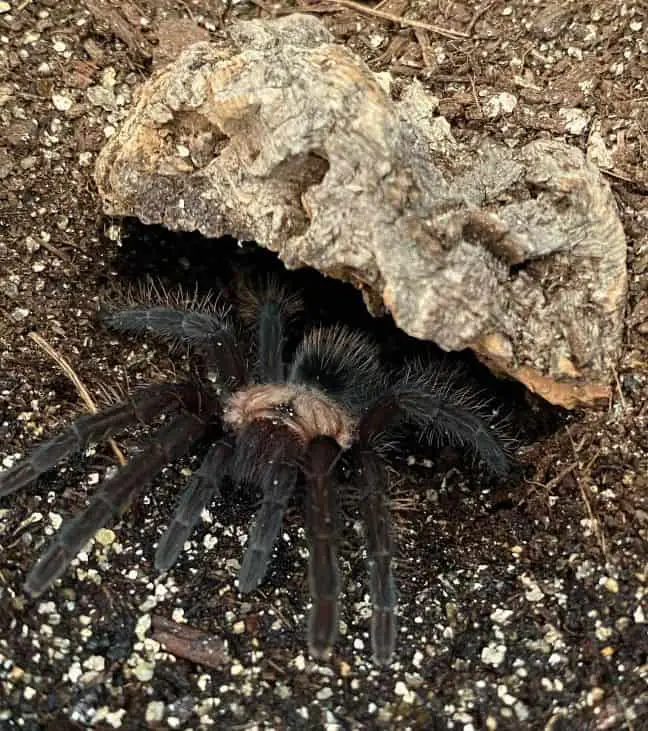The Mexican Rose Grey Tarantula (Tliltocatl Verdezi) is a terrestrial New World tarantula. As the common name suggests, this spider is native to Mexico, more specifically, the Guerrero and Oaxaca regions.
This spider is also popular among hobbyists, who fancy it for its interesting appearance and docile temperament, which makes it very suitable for beginners.
If you’re considering adding a Mexican Rose Grey Tarantula to your collection, here’s everything you need to know to care for them.

Mexican Rose Grey Tarantula Care Sheet
| Name of Species | Tliltocatl Verdezi |
| Family | Theraphosidae |
| Common names | Mexican Rose Grey Tarantula |
| Native location | Mexico |
| Category | New World |
| Type | Terrestrial |
| Leg span | 6 inches |
| Growth speed | Medium |
| Urticating hairs | Yes |
| Diet | Insects, primarily roaches & crickets |
| Social | Solitary |
| Temperature | 70 to 85 °F |
| Humidity | 65 to 80% |
| Life span | Females: 15 years / Males 5 years |
| Experience level | Beginner |
Mexican Rose Grey Tarantula Overview
The Mexican Rose Grey Tarantula is a terrestrial opportunistic borrower, which means that it will use anything it can find to create a burrow.
This species grows to a size of around 6 inches. It goes by the scientific name of Tliltocatl Verdezi but used to be part of the Brachypelma genus until 2019 when it was moved to the Tliltocatl genus.
These spiders are very suitable as pets because they’re docile, beautiful, and easy to care for.
Appearance

The male Mexican Rose Grey Tarantula is characterized by its dark, almost completely black body with red and orange setae on the abdomen and legs. Females have a triangular marking on the front of their cephalothorax and are slightly lighter in color.
This species is not particularly large. Slings are about a quarter of an inch and the leg span of fully grown adults tops out at about 6 inches.
As is standard with tarantulas, females are slightly larger in size
Price
The Mexican Rose Grey Tarantula is not particularly expensive, but not cheap either. On average, expect to spend around $55 for a sling or juvenile. Female adults can be more costly and are often priced around $100 to $200.
Behavior and Temperament
The Mexican Rose Grey Tarantula is among the most docile species in the world. If they do perceive something as a threat, they have a tendency to run away rather than stand their ground and fight.
If they do not have the option to run away then they might strike a threat pose or flick urticating hair, but this is something they only really do if they have no other option. Their urticating hairs are something to watch out for though because they can do serious damage if they land in your eye, mouth, or nose. Thankfully, this spider is not likely to kick their hair as long as you treat them respectfully.
As a last resort, the spider can also bite. Luckily, their venom, like that of most New World species, is very mild and does not pose a threat if you’re not allergic to it.
The Mexican Rose Grey can also be handled. However, this is something that should be approached carefully. While the tarantula might tolerate being handled due to their docile temperament, it is not something that they enjoy or crave. It is fun to do for humans, but the tarantula does not really get anything out of it. If you do choose to handle them, do so carefully and make sure not to drop them as that can rupture their abdomen which can be lethal.
On the whole, the temperament of this species is very suitable for beginners as well as advanced tarantula keepers. They’re chill and relaxed spiders that are a joy to watch.
Caring for the Mexican Rose Grey Tarantula

The Mexican Rose Grey Tarantula is not particularly difficult to care for. As long as you provide them with a proper enclosure that has the right temperature, humidity, substrate, and food, they’ll be more than happy!
Let’s take a look at what the perfect enclosure for these wonderful spiders looks like.
Tank setup
The Mexican Rose Grey is a terrestrial species. As such, they need an enclosure that prioritizes floor space over height.
An enclosure that’s 20″ x 12″ x 10″ such as the Reptizoo 10 gallon is a great choice. It gives the spider plenty of floor space and the height is low enough to prevent falls.
Of course, this enclosure is only for (sub)adults. Slings and juveniles can be housed in smaller enclosures.
Since this spider is an opportunistic burrower, you should also provide them with a starter burrow. A piece of bark is a great choice. Place it halfway in the substrate and the spider will use it to create her home. You can also decorate the enclosure with some rocks and fake vegetation to make the enclosure more appealing.
If you want to go all out, a bioactive enclosure is also a great option. Though bioactive enclosures can be quite difficult to set up, they’re the best way to keep tarantulas in captivity.
Adequate ventilation is also important in any tank.
Temperature and humidity
The temperature that the Mexican Rose Grey Tarantula thrives in is between 70 to 85 °F and the optimal humidity is between 65 and 80%.
The temperature should be relatively easy to maintain for most people since it’s around room temperature. If you do struggle to keep the temperature up you can use a space heater or a non-light-emitting heat lamp.
Make sure that you do not place a heat mat under the enclosure since tarantulas dig to cool down. If you place a heat mat under the enclosure the spider can dig down all the way in an attempt to cool down only for the temperature to get hotter due to the heat mat.
Keeping the humidity high might be more challenging, but it is important. High humidity levels make your tarantula more comfortable and make it easier for them to molt. To keep the humidity levels up you might have to moisten the substrate as well as overfill the water bowl. You might also have to get a hygrometer to keep an eye on the humidity levels.
Substrate
Since the Mexican Rose Grey Tarantula is an opportunistic borrower, they need a substrate that can accommodate that.
A good choice is a mixture of peat moss, vermiculite, coconut fiber, and dirt. This will retain humidity well and is easy for the spider to burrow into.
To give them adequate depth to burrow they need a layer of substrate that is at least 4 inches thick.
Social
Some tarantula species can live communally, but the Mexican Rose Grey is not one of them.
In the wild, these spiders live solitary lives and only meet other members of their species when it’s time to mate. In captivity, housing them communally will inevitably lead to cannibalism and should thus be avoided.
Diet & Feeding
The Mexican Rose Grey Tarantula might be relatively small, but they have a good appetite for their size and can eat a lot.
In the wild, they eat a variety of different insects, as well as small rodents and lizards.
In captivity, they thrive on a diet that consist of insects, primarily roaches and crickets. Adults do fine if you feed them 5 large crickets or 2 roaches a week.
Of course, what they should eat does depend on what stage of their life they’re in. Slings should eat flightless fruit flies until they’re about half an inch in size. At that point, they can start eating pinhead crickets and other very small insects.
As they grow larger, their prey grows with them. Adults of this species can eat a variety of insects. The aforementioned roaches and crickets should be staples in the diets of adults, but they can also eat the occasional mealworm, earthworm, or moth.
When you feed your tarantula it’s important that you do not feed them prey that’s larger than their abdomen. In addition, make sure that you keep an eye on the size of their abdomen. If it’s growing too large you might be feeding them too much. If it’s shrinking, you might want to increase the amount you feed them.
Lifespan & Health
Mexican Rose Grey Tarantulas are hardy species that live relatively long lives. Females can live for up to 15 years, while males typically live for around 5 years.
To keep the tarantula strong and healthy, it’s essential that you prevent the growth of bacteria and mold. Since these spiders need a high-humidity climate mold and bacteria can easily become a problem if you’re not careful.
To prevent mold growth, make sure that uneaten food and shed molts are removed in a timely matter. Adequate ventilation is also important.
Parasites can also be a problem but are easily prevented by feeding your tarantula exclusively captive-bred insects.
Lastly, a big threat for terrestrial species such as the Mexican Rose Grey are falls. When handling them, you have to be very careful that they do not fall to the ground. In addition, you have to make sure that their enclosure is not too tall so that they cannot accidentally climb too high and fall.
Facts about the Tliltocatl Verdezi
- The Tliltocatl Verdezi used to be part of the Brachypelma family until 2019.
- There has been a lot of confusion about this tarantula in the past. They used to have a variety of different names, and at one point the males and females were even thought to be of different species. It wasn’t until 2003 that their taxonomy became more clear.
- The Tliltocatl Verdezi is relatively small for a member of the genus.
Final words
The Mexican Rose Grey Tarantula is an easy to care for, docile, yet beautiful species that would be a welcome addition to any collection.
They might not be the most colorful, biggest, or flashiest species, but they’re a solid tarantula that has a lot to offer to newcomers and experienced keepers alike.
- How Long Do American Eskimo Dogs Live? Important Factors and Care Tips - September 29, 2023
- Do American Bulldogs Need Grooming? Essential Tips and Care Guidelines - September 29, 2023
- Do Bengal Cats Enjoy Playing? Essential Tips for Keeping Them Active - September 29, 2023